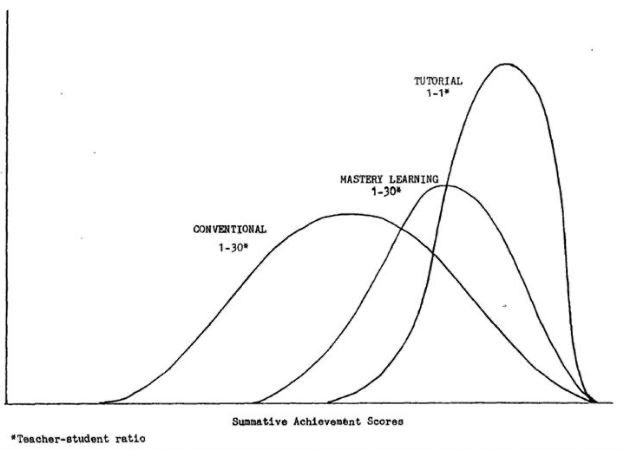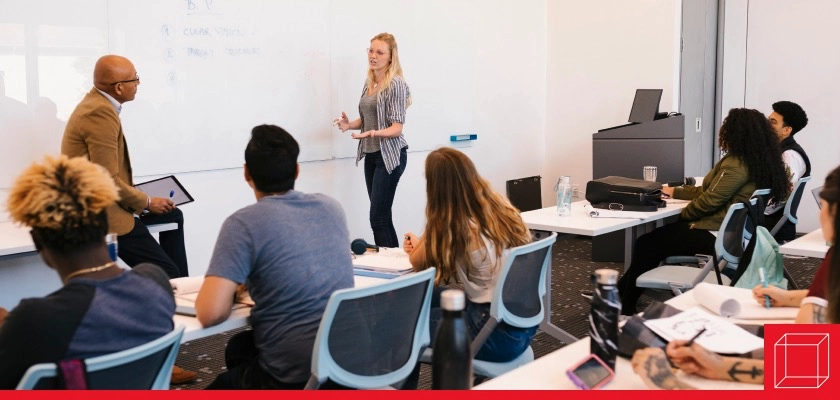The Use of Adaptive Technology to Help Solve Blooms' 2 Sigma Problem
Can adaptive technology offer personalized tutoring to college students and answer Benjamin Bloom's famous 2 Sigma Problem?

In a perfect world, where an instructor is only directly responsible for one student, an instructor would be able to devote his or her attention to the student and would be able to understand how to tailor the curriculum to meet the needs of the student. Too good to be true, right?
As classroom sizes continue to grow, instructors are having to divide their attention between more and more students, limiting the amount of time each instructor has to get to know their individual students. Students, on average, perform two standard deviations better under one-on-one tutoring compared to standardized group instruction. Education professor, Benjamin Bloom described this effect of personalized instruction as the 2 sigma problem. Until recently, the ability for a teacher to provide personalized learning and adaptability to each student has been difficult to achieve.

Adding technology to the classroom is one way Bloom suggested to help increase student success, but merely adding computers and other technology to the classroom with pedagogical arbitrariness has proven to have little effect. With recent advancements, however, educational technologies have grown better at correlating to course curriculum and instructor needs, while decreasing in cost to students.Adding technology to the classroom is one way Bloom suggested to help increase student success, but merely adding computers and other technology to the classroom with pedagogical arbitrariness has proven to have little effect. With recent advancements, however, educational technologies have grown better at correlating to course curriculum and instructor needs, while decreasing in cost to students.
In 2010, I began using one of these tools, LearnSmart, in my courses, and I noticed an improvement in my student’s exam scores. Seeing this exam score improvement at the course-level led me to construct an empirical study to determine if using the adaptive learning technology (ALT) tool, LearnSmart, was directly responsible for this increase in performance. The study sought to determine if using the ALT, LearnSmart, in seated introductory business courses would result in a statistically significant difference in unit exam scores, to analyze changes in exam performance through different time increments used of the ALT, and to investigate correlations between the student’s metacognition in the ALT module and his or her performance on the unit exam. The population of this study consisted of students in nine sections of introductory business courses at three large community colleges in the United States during the fall 2015 semester.
What did the study measure and what were the parameters?
Adaptive learning technologies use algorithms to predict knowledge; therefore, students are able to have a personalized learning experience that ultimately guides them through a constructivist pedagogy in order to learn the material. The ALT assumes the role of the instructor in presenting new constructs to students. The study consisted of having one section of students at each college use LearnSmart for an average of 20 minutes as a preparatory assignment before each chapter. A second section of students at each college used LearnSmart for an average of 40 minutes, and the third section of students at each college, serving as our control group, did not use LearnSmart at all
So what did the study show?
Based on the findings in this study, the use of the ALT, LearnSmart, produced statistically significant improvements in exam scores when used as a mandatory assignment prior to the exam.
The research study also indicated that students performed better on exams when required to complete longer, 40-minute, LearnSmart modules compared to a shorter, 20-minute, LearnSmart modules or not using LearnSmart at all. The mean exam score increase was 13% for the group completing the 40-minute LearnSmart modules.
Another interesting finding is how student metacognition plays a positive role in learning. Students who had higher levels of confidence in their correct answers in LearnSmart were able to perform better on the exam than students who did not have increased confidence. Data from this study and earlier research support the argument that students perform better when students understand what they know and do not know about the subject matter. Students who had higher levels of confidence in their correct answers were able to perform better on the exam than students who did not have increased confidence. This confidence, perhaps, may stem from students who have studied more or have more prior knowledge of the subject matter, thus giving them more confidence when taking the exam. It could also arise from students who were more serious than others in answering the metacognitive confidence questions found under the subject matter questions on the LearnSmart screens.

Takeaways on preparatory assignments, metacognition, and active learning
Extrapolating from the research study, adding preparatory assignments that involved the use of generation and active learning have been shown to increase student engagement and performance. Generation, the act of filling in missing information, even in small amounts, fosters a learning environment that forces students to have ownership over the material. Since generation exercises involve active learning, students show higher levels of engagement, thus yielding higher performance. Adaptive learning technology is active and contains various forms of generation, and ALT has the ability to elevate student engagement and adapt the material to each student.
Additionally, more emphasis on metacognition should be required in instructional strategies. Students who had a better understanding of what they actually knew and what they did not know were able to perform better on the assessment. While not perfect, the incorporation of ALT – specifically with focus on technologies that incorporate metacognition and active learning exercises – should be considered by faculty as a means of improving exam performance and taking us a step closer to solving the elusive 2 Sigma Problem.

